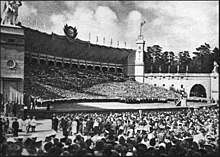Mežaparks Great Bandstand

The Mežaparks Great Bandstand (Latvian: Mežaparka Lielā estrāde), also called the Song Festival Bandstand, Open-Air Stage (Latvian: Dziesmu svētku estrāde), is a large open-air bandstand in the Mežaparks neighborhood of Riga, the capital of Latvia. The bandstand has added cultural value to Riga since 1955, when the Latvian Song and Dance Festival was moved to this venue.[1]
The bandstand was erected according to a project by architect and civil engineer Vladimir Schnitnikov. It lies in the northern part of Mežaparks, an area that mostly consists of pine forest. Within the cleared area of the forest, the bandstand lies in the northwestern corner, and the rest of the area has long wingshaped benches with seating for 30,000 spectators. There were up to 200,000 spectators attending the 1988 Latvian Song and Dance Festival.
The stage is integral part of the Song and Dance Festival which is a unique feature of Latvian culture and a part of national identity. The key function of an open air stage is to keep the tradition of Song Festival, which is included into UNESCO culture inheritance list.
Reconstruction
In the mid-2007 the Riga City Council announced a new – international – design competition. The competitors were expected to produce rational, structurally innovative and acoustically impeccable proposals for transformation of the stage what would include the roof with a system of acoustic elements, partial transformation of chorister stands, transformation of the spectator amphitheatre, construction of new stands at the rear part of the amphitheatre and installation of transformable spectator bench systems.
The winner of the International Sketch Competition for the Mežaparks Open-Air Stage Reconstruction has become Latvian Architects collaborative team - Mailitis Architects and Juris Poga's Bureau.
Project reconstruction has been divided into two phases :
The first phase of the Open-Air Stage in Mežaparks reconstruction project involves reconstruction of the audience area for the 2018 Latvian Song and Dance Festival with audience field extension to 30 557 seats ( 23 000 seats before). Transformable audience field increased the capacity to 60 000 standing places. There is two level open zone for shops, restaurants and toilets under the audience area. The first phase of the project extending existing building stage structure and partly attaching temporary tribune for extra singers to fit 14 000 singers.
The first reconstruction phase has been completed by June 2018.
The second reconstruction round will rebuild all open-air stage, a roof and modify building. Auxiliary premises will be built under the stage, including an exhibition hall and offices. It is planned to complete the project till 2023 when Latvian Song and Dance Festival is going to take place in Mezaparks. Project includes unique acoustic methods – 300 acoustic shields, and a special membrane protecting choristers from the sun and rain.
Completely finishing all the works, there will be 30 000 spectator seats, total number of singers will be up to 14 000- 11 000 singers will stand on tribunes and 2900 singers on stage.
References
Coordinates: 57°0′56.30″N 24°9′4.19″E / 57.0156389°N 24.1511639°E